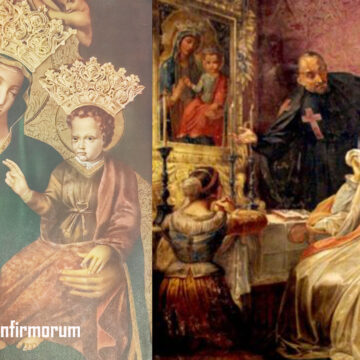Luciano Sandrin – Camillian
 Amongst the various dimensions that characterise God’s revealing of Himself in Holy Scripture, that of compassion expresses in an important way His special love for us. In all the metaphors that the Bible employs, God’s ‘drawing near’ to man is constantly described as ‘com-passion’, in the deepest meaning of the word; an ‘allowing oneself to be moved’ by the other and taking part at a deep level in his or her experience. Man, in his condition of frailty, weakness and vulnerability is the quintessential setting for the compassion of God; it provokes His intervention. God feels compassion for His people, He is moved and He works for His people’s liberation (Ex 3:7-10).
Amongst the various dimensions that characterise God’s revealing of Himself in Holy Scripture, that of compassion expresses in an important way His special love for us. In all the metaphors that the Bible employs, God’s ‘drawing near’ to man is constantly described as ‘com-passion’, in the deepest meaning of the word; an ‘allowing oneself to be moved’ by the other and taking part at a deep level in his or her experience. Man, in his condition of frailty, weakness and vulnerability is the quintessential setting for the compassion of God; it provokes His intervention. God feels compassion for His people, He is moved and He works for His people’s liberation (Ex 3:7-10).
The Compassion of the Samaritan
‘Who is my neighbour?’ This is the question that a doctor of the law, an expert on sacred things, addresses to Jesus when asking him to clarify the invitation-commandment: ‘love… your neighbour as yourself’ (cf. Lk 10:25-37). Jesus does not give a list of possible candidates for the neighbour who should be loved. He tells the parable of the Good Samaritan, making it be understood that the problem is not so much defining beforehand who the neighbour is that should be loved but, rather, how to make yourself a neighbour to those you do not expect to meet (those who pass on the road of your hurrying and your engagements), allowing yourself to be moved and stopped by their pain. Jesus made the Samaritan an example to be imitated.
The Samaritan is he who made himself mercy for the other and thus he can fully represent God who in Jesus became mercy and compassion for us: he allowed himself to be touched in his heart and shared our suffering. The parable narrated in the gospel of Luke is an invitation to do: to the question of the scribe as to what he should do to have eternal life, Jesus answers that one has to do what that Samaritan did. Compassion is not simply having pity for the other; nor does it stop at empathy. It becomes, rather, nearness, action, a relationship, care, and expresses its full truth in this doing.
In a pastoral relationship, compassion can be assertive, define boundaries, be honest, and be not ready to give other people what they want, but, rather, what they really need. And it does not create dependence. A wounded man rediscovers his freedom specifically in the relationship of love with the Samaritan. But the Samaritan, after providing help, after taking the wounded man to the inn, after taking care of him, and after assuring the innkeeper that he would pay for any costs involved, continued on his journey. No person that we help must thus become ‘ours’ and impede him or her, and us, from continuing on our journeys. If we are sufficiently free and sufficiently strong, we can help other people without drawing away from our pathways, making ourselves neighbours to the other without forgetting to be neighbours to ourselves; having concern and compassion for the other but also for ourselves.
A Samaritan Church
 Go and do likewise! is not, however, addressed only to individuals who can do this with professionalism and love. It is also the task of groups and the community as a whole. Compassion must characterise the pastoral care (acting and inter-acting) of the whole of the community. The parable of the Good Samaritan has been read, on the whole, as a model for the behaviour of individual Christians, forgetting that becoming a neighbour is a mission for the whole of the ecclesial community. It is the whole of the Church that, in a special way, is called to continue the work of Jesus the Good Samaritan. The compassion of the Good Samaritan must be embodied in the action of a ‘Samaritan Church’; of a ‘Church that is a field hospital’, to use the words of Pope Francis; of a Church that is capable of binding wounds, of establishing nearness, and of warming the hearts of the faithful.
Go and do likewise! is not, however, addressed only to individuals who can do this with professionalism and love. It is also the task of groups and the community as a whole. Compassion must characterise the pastoral care (acting and inter-acting) of the whole of the community. The parable of the Good Samaritan has been read, on the whole, as a model for the behaviour of individual Christians, forgetting that becoming a neighbour is a mission for the whole of the ecclesial community. It is the whole of the Church that, in a special way, is called to continue the work of Jesus the Good Samaritan. The compassion of the Good Samaritan must be embodied in the action of a ‘Samaritan Church’; of a ‘Church that is a field hospital’, to use the words of Pope Francis; of a Church that is capable of binding wounds, of establishing nearness, and of warming the hearts of the faithful.
The Christian community has the ‘con-soling’ task of narrating in its actions of nearness, of care, of comfort and of hope the compassionate God who proclaims in the gospel that he the transparancy of the maternal face of the Father. For those who suffer, the compassion of God takes form, most of the time, in our love: it is expressed in our care and in our words. It is in love for the other that we bear witness to God. Benedict XVI reminded us of this in his Deus caritas est: ‘a pure and generous love is the best witness to the God in whom we believe and by whom we are driven to love. A Christian knows when it is time to speak of God and when it is better to say nothing and let love alone speak. He knows that God is love (cf. 1Jn 4:8) that God’s presence is felt at the very time when the only thing we do is love’ (n. 31). And it is love that can mitigate the loneliess of those who suffer; it is the best ‘con-solation’ (Spe salvi, n. 38).
The Christian community is called ‘be a memory’ of the compassion of Christ towards those people who are most frail; of his commendment to proclaim the love of God; and to take care of the many wounded people that she meets on her journey: works of mercy, both old and new, in which Jesus makes himself present still today, as a beneficiary and as a benefactor.
The Christian community is called to rediscover pastoral care in its various expressive forms as ‘com-passion’: the capacity to share, in a ‘conjugal faithfulness’, the experiences of other people – in joy and in pain, in health and in illness; to share gifts that have been received and to be a travelling companion to them on their life journeys. In this can be expressed the great heart of God for the poor (‘miseri-cordia’, ‘mercy’) and an authentic form of pastoral theodicy.
Further reading:
Sandrin L., Aiutare gli altri. La psicologia del buon samaritano (Paoline, Milan, 2013).(Spanish edition: Ayudar a los demas. La psicologia del buen samaritano, Sal Terrae, Maliañ-Cantabria, 2014).
Sandrin L., Lo vide e non passò oltre. Temi di teologia pastorale (EDB, Bologna, 2015). (Spanish edition: Teología pastoral. Lo vio y no pasó de largo, Sal Terrae-Centro de Humanización de la Salud, Maliaño/Cantabria-Madrid, 2015).














Camillians on Facebook
Camillians on Twitter
Camillians on Instagram